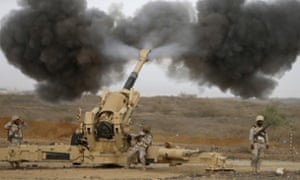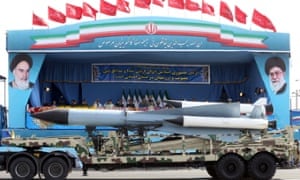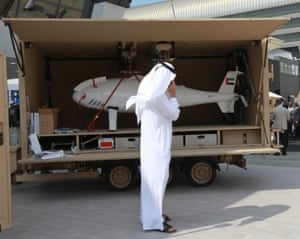The $18bn arms race helping to fuel Middle East conflict
http://www.theguardian.com/Security experts express fears for region’s stability amid record weapons sales from west and Russia’s missile deal with Iran

The Middle East is plunging deeper into an arms race, with an estimated $18bn expected to be spent on weapons this year, a development that experts warn is fuelling serious tension and conflict in the region.
voluntarily blocked by Russia since 2010 – seems likely to further accelerate the proliferation.
That will see agreed arms sales to the top five purchasers in the region - Saudi Arabia, the United Arab Emirates, Algeria, Egypt and Iraq – surge this year to more than $18bn, up from $12bn last year. Among the systems being purchased are jet fighters, missiles, armoured vehicles, drones and helicopters.
The Russian declaration came only two days before Iraq’s prime minister, Haider al-Abadi, disclosed he was seeking arms worth billions of dollars from Washington – with payment deferred – for the battle against Islamic State (Isis).
Last week France’s foreign minister, Laurent Fabius, disclosed progress in talks to sell Rafale fighter jets to the UAE, one of the Middle East’s biggest and most aggressive arms buyers.
With conflicts raging in Syria, Iraq, Libya and Yemen, and with Egypt also battling Islamist extremists in the Sinai, the signs that Russia is preparing to increase its own arms sales – and to the Gulf states’ biggest rival, Iran – are raising fears that tensions will be stoked further still.
In particular Saudi Arabia and Iran are facing off in the conflict in Yemen where, despite the announcement by Riyadh on Tuesday that it had halted its month-long bombing campaign, jets continued to strike Houthi rebel positions close to the capital Sanaa, around the third city Taez, and in the central town of Yarim.
According to the New York Times, defence industry officials have notified Congress that they are expecting additional requests from Arab states fighting Isis – Saudi Arabia, the UAE, Qatar, Bahrain, Jordan and Egypt – for thousands of new US-made weapons, including missiles and bombs, to rebuild depleted arms stockpiles.
Ironically, among the key weapons suppliers in the arms race are permanent members of the UN security council who have been at the centre of two unconventional arms control initiatives – disarming the Syrian government’s stockpiles of chemical weapons and negotiating for a deal on Iran’s nuclear programme.
The scale of the arms race was revealed this year in reports published by IHS Jane’s Global Defence Trade Report and the Stockholm International Peace Research Institute (Sipri). They showed how Saudi Arabia had become the world’s largest importer of weapons and fourth-largest military spender and that other Middle East states were sharply increasing their arms purchases.
Adding to concern is that the spending spree on arms comes against the background of a marked increase in military interventions by countries in the region since the Arab spring in 2011.

Saudi Arabia has intervened in Bahrain (at the request of that kingdom’s ruler during the so-called Pearl revolution), in Yemen in 2009 and again in Yemen this year.
In addition, a new Saudi-led and largely Sunni military alliance – announcedthis year and dubbed the “Arab Nato” – appears primarily designed as a new foil to Iran in the widening proxy conflict between Riyadh and Tehran.
And among those concerned by Saudi’s new military assertiveness - on the back of its arms buying spree - was the Iraqi prime minister, Abadi.
“The dangerous thing is we don’t know what the Saudis want to do after [their intervention in Yemen],” Abadi told US reporters last week. “Is Iraq within their radar? That’s very, very dangerous. The idea that you intervene in another state unprovoked just for regional ambition is wrong. Saddam has done it before. See what it has done to the country.”
And if the Saudi intervention in Yemen has been overt, no less real has been the proxy conflict that has set Iran and the Gulf states against each other in Syria, where Tehran has backed the government of Bashar al-Assad with military assistance and weapons, and Gulf states have backed different rebel groups, including Islamist ones.
“It’s crazy,” says Ben Moores, author of IHS Jane’s annual report on arms buying trends. “The one Canadian deal alone – to supply Saudi Arabia with light armoured vehicles – will account for 20% of the military vehicles sold globally in years covered by the contract. And this is just the thin edge of the wedge. Saudi has booked enough arms imports in 24 months for them to be worth $10bn a year.”
While some countries, such as Kuwait, are in the process of modernisation, a key trend identified by Moores is how states are retooling to fight insurgency conflicts in the same way the US military has in Afghanistan and Iraq.
“Look at UAE, Saudi Arabia, Egypt and Algeria. They were all countries that bought a lot of conventional arms in the past that are no use in a sectarian war or an insurgency.
“If you look at what was bought at the recent Idex arms fair in Abu Dhabi it was drones, high-end surveillance satellites, strategic transport aircraft for projecting power. One of the reasons Egypt went with its recent purchase of Rafale jets [from France] is because it wanted planes that could deliver precision-guided standoff weapons.
And as Tobias Borck of the Royal United Services Institute points out, states in the Middle East are now more prepared to use the weapons they are buying.
“[The] Saudi-led military operations in Yemen [are] the latest manifestation of Arab interventionism, a trend that has been gaining momentum in the Middle East since the uprisings of the Arab spring,” he says. “Middle Eastern countries appear to be increasingly willing to use their armed forces to protect and pursue their interests in crisis zones across the region.”
Referring to the inconsistent approach by key security council members towards arms control in the region, he adds: “There are a lot of different streams feeding into this arms race.
“On Syria’s chemical weapons and the Iranian nuclear programme the two issues were ringfenced as pure arms control questions. When it comes to how we perceive our arms sales – whether they are British or US or whatever – it tends to be seen as a domestic economic issue – protecting our factories.
“That neglects the regional political dimensions, with arms sales taking place with a lack of regard for that context and without long-term strategic awareness.”

Borck says the sheer scale of the arms being supplied to countries such as Saudi Arabia and the UAE by the west may also be acting as an incentive for Russia to get back into the Middle East – not least via arms sales to its old clients such as Iran – and may have been a motivating factor in the Kremlin’s decision to lift the ban on the delivery of the S-300 missile system.
Putin, defending the decision to supply the missiles during a call-in television show last week, cited Russia’s prerogative to pursue its own foreign policy initiatives and suggested the missiles could represent “a deterrent factor in connection with the situation in Yemen”.
Omar Ashour, an expert on Middle East security issues at Exeter University, adds another caution, this time over the intentions of the new Saudi-led Arab coalition, warning that its interventions are unlikely to contribute to stability.
“The rise of Arab military coalitions raises serious concerns,” he wrote in a recent piece for Project Syndicate. “Such interventions were usually aimed at empowering a proxy political force over its military and political rivals, instead of averting humanitarian disaster or institutionalising a non-violent conflict-resolution mechanism following a war.”
Speaking to the Guardian last week, he added: “On top of that, the increases in arms sales are bound to be extremely destabilising. At the moment most of the interventions have been against softer targets – Saudi Arabia targeting guerrillas in Yemen; Egypt against Bedouin in Sinai; or strikes against ragtag armies in Libya.
“But if the ‘soft’ keeps being hit hard they won’t remain soft. They will find their own patrons and proxies and hit back and it will lead to a vicious cycle.”
Pieter Wezeman, a senior researcher at Sipri, which maintains a database tracking arms contracts, raises another concern. “Something that doesn’t get mentioned is the complete lack of interest in arms control among the countries in region. It is not in the minds of leaders and decision-makers except for the need to arm to defeat any potential opponent.
“There is already instability in the region on several levels. You have instability in Yemen, Syria and Iraq. There is instability between Iran and the Gulf states. What is important now is how the massive expansion of the armed forces of Saudi Arabia, UAE and Qatar will be seen as posing a clear threat to Iran.”
Borck adds a final warning: “If you are going for an ever-bigger hammer, then the more desperate you are to make every problem a nail.”
No comments:
Post a Comment